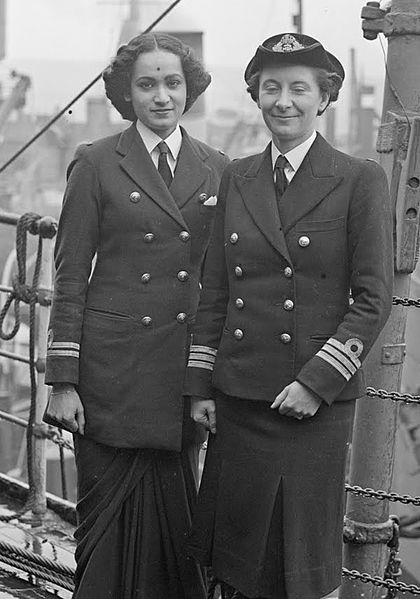In World War Two, those responsible for the integration of the women’s services into the male structures of the armed forces were able to draw on the experience of the First World War, and very rapidly a working system evolved. In this, the female Wrens were set their tasks and were answerable to the male Royal Navy for the performance of their duties, but all other aspects of their service lives were controlled by the female structure of their own service.
Early WRNS uniforms
This meant that their uniforms were designed and created by women, for women and this notion was particularly strong in the Wrens. Within a need for them to look as though they belonged to the Navy, Wrens’ uniforms were created for practical comfort as well as neat smartness. And the original outfit of fore and aft jacket, white shirt (with detached stiff collars), black tie, and navy-blue skirt over black stockings, answered the call very well for office type jobs from secretary to teleprinter operator. From an early stage, though, it became clear that more practical clothes were needed for the myriad of other jobs which the Wrens took on. This started with the blue and white dresses of the cooks and stewards but soon spread much further.
The evolution of WRNS uniform
The big change was the change to trousers for many of the jobs. In a world where women in trousers were still a relative rarity, the needs of war changed that fundamentally and for ever. Blue boiler suits, tending to be on the voluminous side for most women, were adapted with belts for many practical manual jobs. In the fleet air arm this was taken a step further when Radio maintenance Wrens flew to test their radios and wore full flying suits. That special group, the boat crew Wrens, wore matelot’s bell bottoms with blue shirts and heavy garnseys. Over that, sou’westers, oilskins and heavy naval sea boots were the norm. As the war progressed many of the specialist groups moved to wear the naval white front, the sailor’s shirt with blue-edged square neck. This is a surprisingly practical garment which was used in many ways. But no matter what they wore, every Wren retained her smart number one uniform for ceremonial and special occasions, marching and drilling to look their very best.
Wren Officers’ Uniforms
The Wren officers’ uniforms were always towards the smarter end of the scale. Being tailor made they were always a good fit and as most officers’ jobs did not involve manual tasks they stayed in white shirt, blue skirt and black stockings. For officers, the smart tricorne hat was always a major attraction. There were exceptions such as the boarding officers who had to be equipped for climbing over obstructions, climbing up rope ladders and working their way round the obstacles in merchant ships to find a captain and give him his orders.
Practical and useful style
But in a country at war and always short of materials, workwear uniforms tended to the practical and utilitarian to suit the job. Whether a welder repairing ships, a gardener looking after shore base grounds or a cook turning out hundreds of meals three times a day, their work uniform tended to the practical and useful. But in the midst of this, an interestingly feminine syndrome prevailed. Wrens of all sorts were encouraged to wear makeup whenever practical and not to lose their femininity in the midst of working and living in a utilitarian male world.
Chief Officer Margaret L Cooper, Deputy Director of the Women’s Royal Indian Naval Service (WRINS), with Second Officer Kalyani Sen, WRINS at Rosyth during their two month study visit to Britain
(Source http://www.oldindianphotos.in/2010/01/india-in-second-world-war-part-3.html)


